6 Months Before My Wedding, I Faced a Life-Threatening Diagnosis
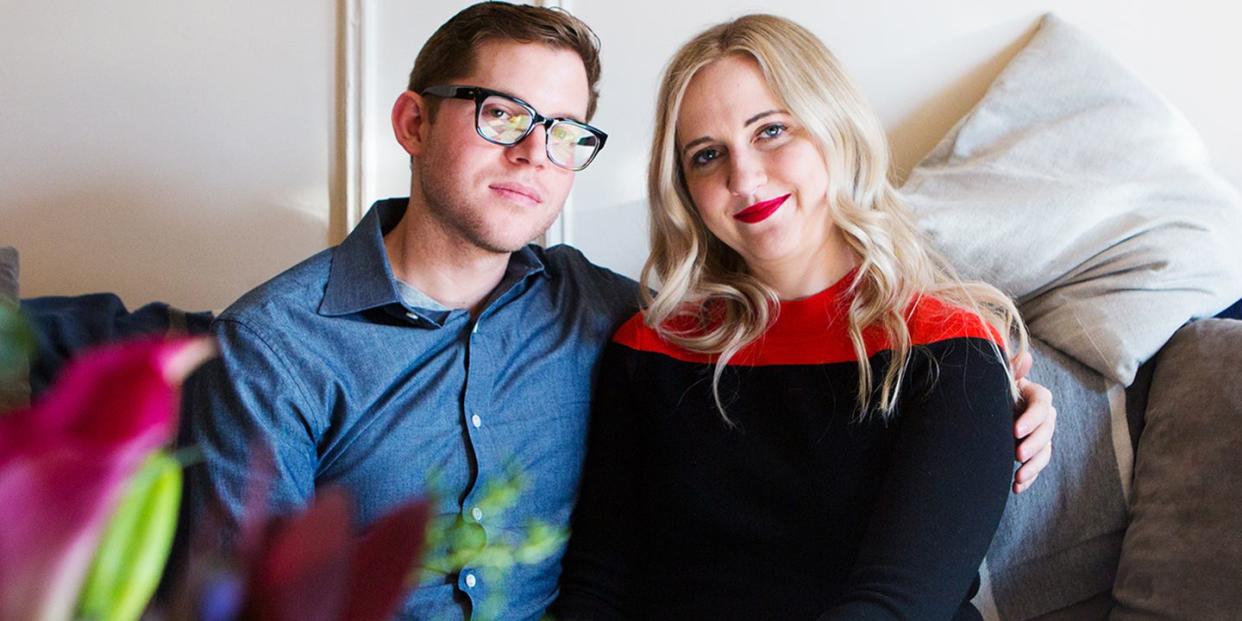
On the first Friday in May 2017, I was sipping rosé with one of my bridesmaids at her Brooklyn apartment, talking about my upcoming November wedding. I showed her my Pinterest boards, and we laughed about my absurd obsession with stationery. On Saturday, I got my hair colored. I felt bloated and uncomfortable, but blamed it on indulging too much the night before. On Sunday, I woke up crying in agony - it felt like my abdomen was being stabbed with white-hot daggers. My stomach was hard and swollen, which I knew from Grey’s Anatomy is never a good thing. We have to go to the ER, my fiancé, Mike, told me. He helped me into an Uber. On Monday, I was a 30-year-old with ovarian cancer.
From the Uber, I’d ended up at the local Emergency Room. At first, the doctors thought my appendix had ruptured, and performed a pelvic ultrasound. But it wasn’t that, so they gave me a CT scan to get a better look at my abdominal cavity. It could be a torsion, they said, where your ovary twists over on itself and causes internal bleeding – an incredibly painful event. I stayed in the ER all day Sunday, and tried to remain calm by joking with Mike about how upset I was that I’d likely have to miss a day or two of work. But I could sense that something was very, very wrong inside my body.
When the results of the CT came back, my doctor reported back soberly: “We found a large mass in your abdomen, around 17 cm,” she said. “But if that were the case, you should be screaming in pain.” I looked at her and shrugged. “I’m not really one to make a fuss,” I told her, loopy from the constant drip of morphine and my own nerves.
She insisted I go to the main branch of New York University hospital for further testing, so I was wheeled out of the ER on a gurney and loaded into an ambulance. Mike rode with me, carrying a clear plastic bag full of my personal effects and looking petrified. The sirens wailed all the way from Brooklyn Heights to midtown Manhattan. “This is probably the fastest commute you’ll ever have to NYU,” I joked to Mike. He smiled wanly.
It was nighttime by the time I got to NYU, but I was immediately examined by a roomful of doctors who told me I’d need an MRI first thing Monday morning so they could get a clearer idea of what exactly the mass in my abdomen was. Still on heavy painkillers, I dozed fitfully Sunday night. Mike, a psychiatry resident at NYU, crashed on a co-resident’s sofa in the nearby resident housing. I knew he was probably also awake with worry, and I felt helpless to reassure him. All I could do was try to rest.
The next morning, I put my vintage opal and diamond engagement ring into a neon pink plastic case and slid into the MRI machine. Take deep breaths, the technician instructed me, but I struggled to take in more than a shallow gasp through the intense pain in my stomach. As we waited for the results, Mike climbed into my hospital bed with me and we held each other close with “SpongeBob SquarePants” playing in the background. It felt so peaceful and comforting and oddly normal in the middle of this strange, futuristic environment, where everything was confusing and full of fear.
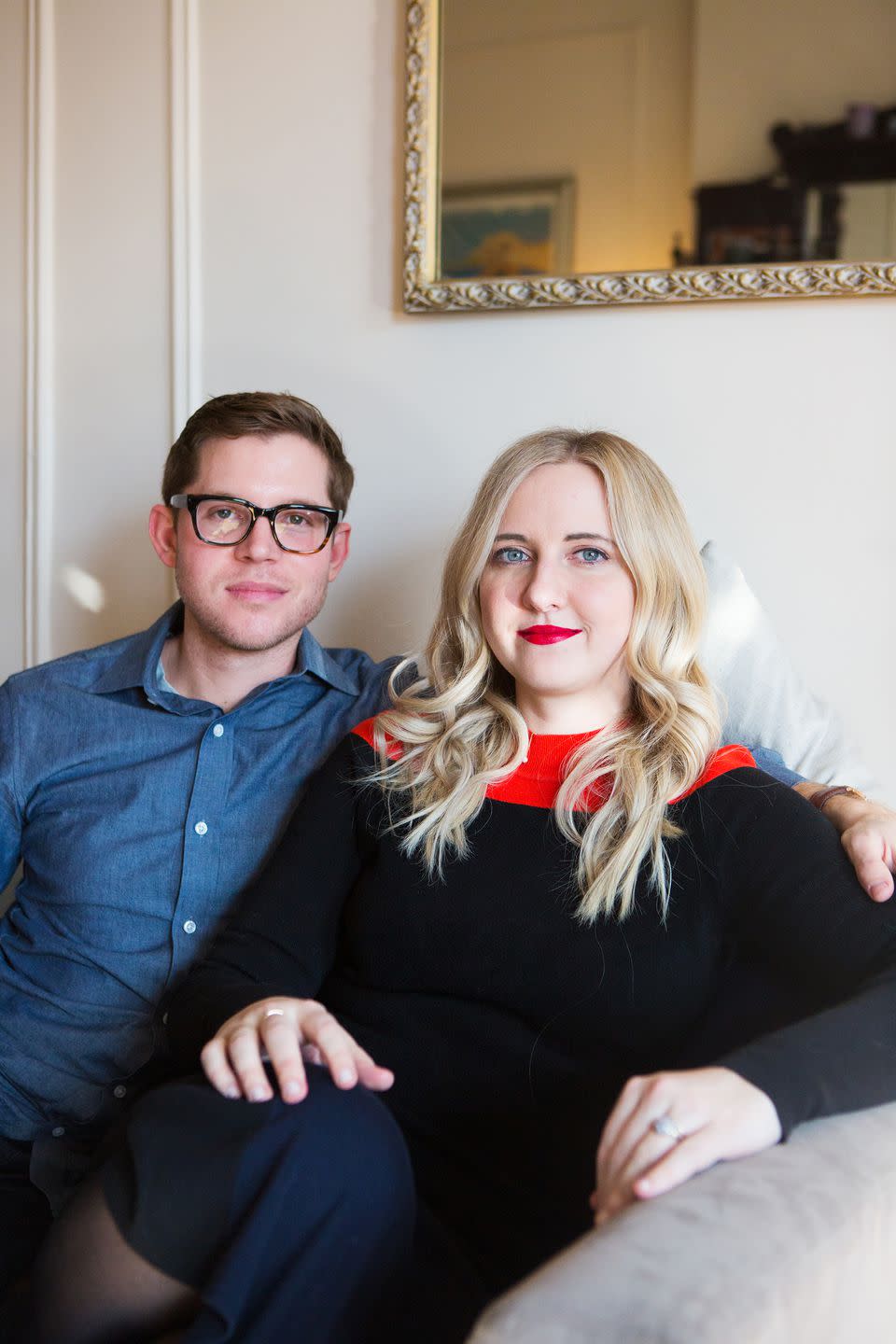
It didn’t last long. An hour later, a gynecologic surgeon came into my room and told me I needed to be rushed into emergency exploratory surgery. They still didn’t know what the mass was, only that it had ruptured and there was a significant amount of blood filling my abdomen. I asked if the surgeon could operate laparoscopically, meaning a much smaller incision and shorter healing time. “No, I’m afraid not,” he said. “I’ll need to perform a laparotomy – you’ll have a large scar starting at your belly button, going all the way to your pelvic bone.” In my heavily medicated state, I felt so numb that I couldn’t process it – I just wanted the pain to end.
“Fine,” I said. “Let’s get this over with.” I signed a stack of paperwork - my life was theirs now - and was wheeled to the surgical floor, with an anesthesiologist walking alongside my bed, telling me what it would be like to go under. I had been in a bad car accident in high school and had needed major surgery, so I assured him it would be old hat. It was a dark and scary moment, but it felt right the go in with bright spirits. He chuckled and rolled me into the surgical prepping suite, where at least a dozen doctors and nurses stood, waiting for me. “Can you count down from 10?” the anesthesiologist asked. I made it to 8.
I was shaken awake rather harshly. “Beth? Beth!” someone kept saying. I blearily opened my eyes. I was somewhere bright and cold, a place that smelled of antiseptic and bleach – the post-op recovery room. A nurse was standing over me. “Your surgery went well,” she said. Mike was standing behind her, looking pale and weary. “Am I OK?” I asked, but they just exchanged a glance, and the nurse went to fetch my surgeon. Still groggy from the anesthesia, all I remember him saying was, “14 biopsies,” “ruptured tumor” and “cancer.” I didn’t believe it – like anyone who is (relatively) young and (fairly) healthy, my diagnosis came as a shock that rattled all my expectations of what my life was and what it was going to be. I was supposed to be planning my wedding; now I was a cancer patient planning my treatment.
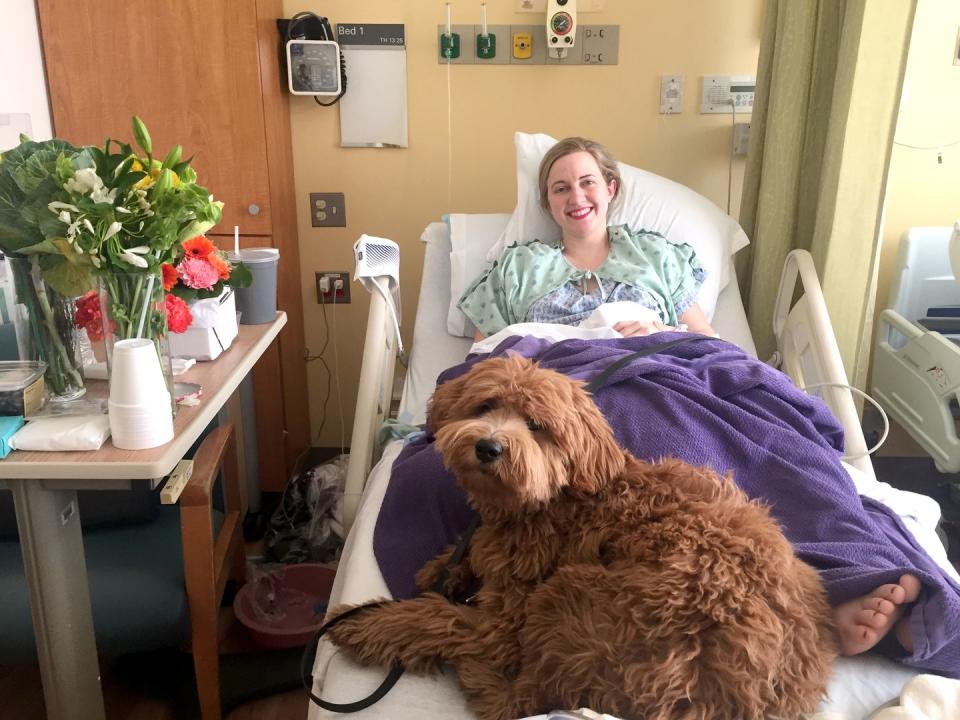
Hours later in my room in the oncological-gynecology suite, I would be lucid enough to hear all of the details – that I had an extremely rare form of ovarian cancer, a granulosa cell tumor (GCT) the size of a large grapefruit. Out of a possible 4 stages, was staged 1C, meaning the tumor had ruptured and cancerous cells were found beyond where the ovarian tumor was. My surgeon had removed the tumor, my right ovary and right fallopian tube, and biopsied 14 places in my abdomen, including my bladder, uterus, intestines, and stomach to test for cancerous cells.
That first day after surgery was full of pain and fear. My recovery room nurse removed my catheter, and the first time I had to get up to pad to the restroom in my forest green slipper socks, I looked down at my body. My once-slim mid-section was swollen beyond recognition, peppered with angry purple and yellow contusions. When I got to the bathroom mirror, I saw my eyes were nearly swollen shut from the IV fluids, and I was deathly pale from losing more than three pints of blood on the operating table. There was a large gauze pad covering my 9-inch incision. Every movement triggered pain. Every molecule in my body ached.
The next day was Wednesday, and as I lay in my hospital bed, Mike and I spent hours talking about the wedding - whether we wanted to postpone it, downsize it, or cancel it altogether. Everything about my life was completely up in the air. Had my cancer spread? Was it likely to come back in a few months? Even if the surgery was curative, how could I know I’d be ready and well enough to walk down the aisle in six months? It was agonizing to speculate about what may or may not happen, and - overwhelmed - we dropped the conversation. I put on a brave face for Mike and for my friends because I felt like everyone wanted to see me strong. They wanted to see someone who could conquer cancer. Inside, I was crumbling, barely able to eat the mushy oatmeal an orderly put in front of me every day and constantly on the verge of tears.
My days in the hospital were marked by early wake-ups, when surgeons would do rounds, prodding my incision and mumbling medical terms over my head, and sporadic visits from my friends and Mike’s co-residents. I was still in a great deal of pain, but due to doctors' fear around the opioid epidemic, I had to beg for strong meds – I was given OxyContin right after my surgery, but from day two on, my nurses tried to convince me that a high dose of Tylenol was all I’d need.
Nights were the hardest. Mike had to leave when visiting hours were over, and the lackadaisical night nurses would disappear for hours at a time, leaving me to extricate myself from the circulation cuffs around my ankles and waddle to the bathroom with my IV tower in tow. I felt unsteady, exhausted, and upset at having to struggle to complete the most basic tasks.
After four days in the onc-gyn unit, I was discharged, my incision still red and raw and my body still so bloated from post-surgical swelling and IV fluids that Mike had to run to a nearby Gap to buy me XL pajamas to wear home, because the yoga pants and T-shirt I’d come in no longer fit. I was spent emotionally and physically, and the days and weeks ahead terrified me. Aside from the incipient slog of recovery, our hospital bills were foremost in my mind.
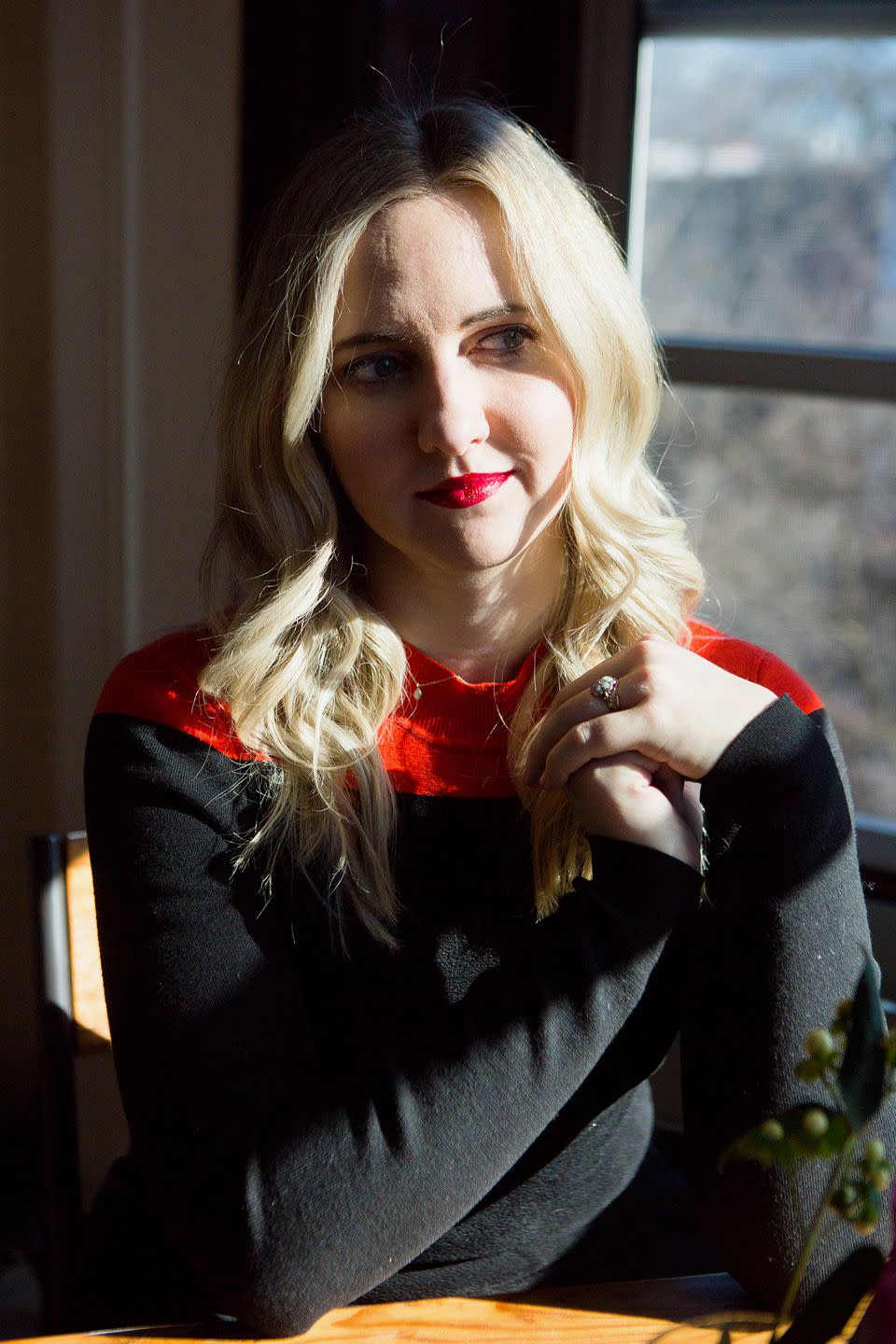
As a doctor, Mike knew how exorbitant the cost of surgery and prolonged hospital stays could be, and he tried to advocate on my behalf to make sure everything was in-network. Still, hospitals often contract parts of surgeries or services, meaning our bill could very easily climb into the high six-figures, and we’d have no way of knowing until months later, when we’d get it in the mail.
I had insurance through Mike (we became domestic partners in 2015 so I could get on his plan), but according to a 2016 Kaiser Family Foundation study, 75 percent of people with insurance said they still couldn’t afford their insurance copays, deductibles, or co-insurance once hit with large medical bills, and a 2015 poll of American adults in seven states by the Robert Wood Johnson Foundation and the Harvard T.H. Chan School of Public Health found that 26 percent of survey participants claimed medical bills were ruinous to their household’s bottom line. On $170 a week (pre-tax!) of disability pay while I wasn't able to work and Mike’s resident salary in a high-cost city like New York, we were flailing. How could we even think about putting money towards a wedding now?
Still, we decided to ignore our fears and to celebrate life - we'd cut costs and get married in November, come hell or high inhibin count. We canceled my bridal shower, bumped my bachelorette party from June to October, and in lieu of registering for things like a blender or a Kitchen-Aid, I asked for donations to help with hospital bills. It felt like the right thing to do. The future felt anything but certain and, I thought, I may not even be around to enjoy things like new linens or dinner plates. (In the end, my hospital bill was upwards of $130,000. Mike’s insurance covered a majority of it, but the number was overwhelming.)
At a follow-up appointment with my oncologist-gynecologist in May, I was told I didn’t need any additional treatment for the time being. GCT often doesn’t respond well to radiation or chemo, and my cancer hadn't spread to nearby organs. It felt like a sign that we had made the right choice to move forward with the wedding, and in the midst of all this, wedding planning proved to be both a welcome distraction and a total frivolity. Some days during my recovery, I was grateful to fuss over canapés and place settings instead of Googling the survival rates of women with ovarian cancer (for stage 1C, anywhere from 50 to 85 percent over five years); other days, I wanted to scream into the void that none of it mattered.
Some things, it was hard not to care about. With my hormones askew from being one ovary down and the stress of my diagnosis, I’d put on over 40 pounds, which meant the gorgeous Carolina Herrera gown I thought I would wear to marry Mike would remain in its garment bag, unworn. I went emergency wedding dress shopping a month before the big day, scrambling to get alterations done in time. Every new detail felt like a sad compromise, as I bid farewell to my dream wedding.
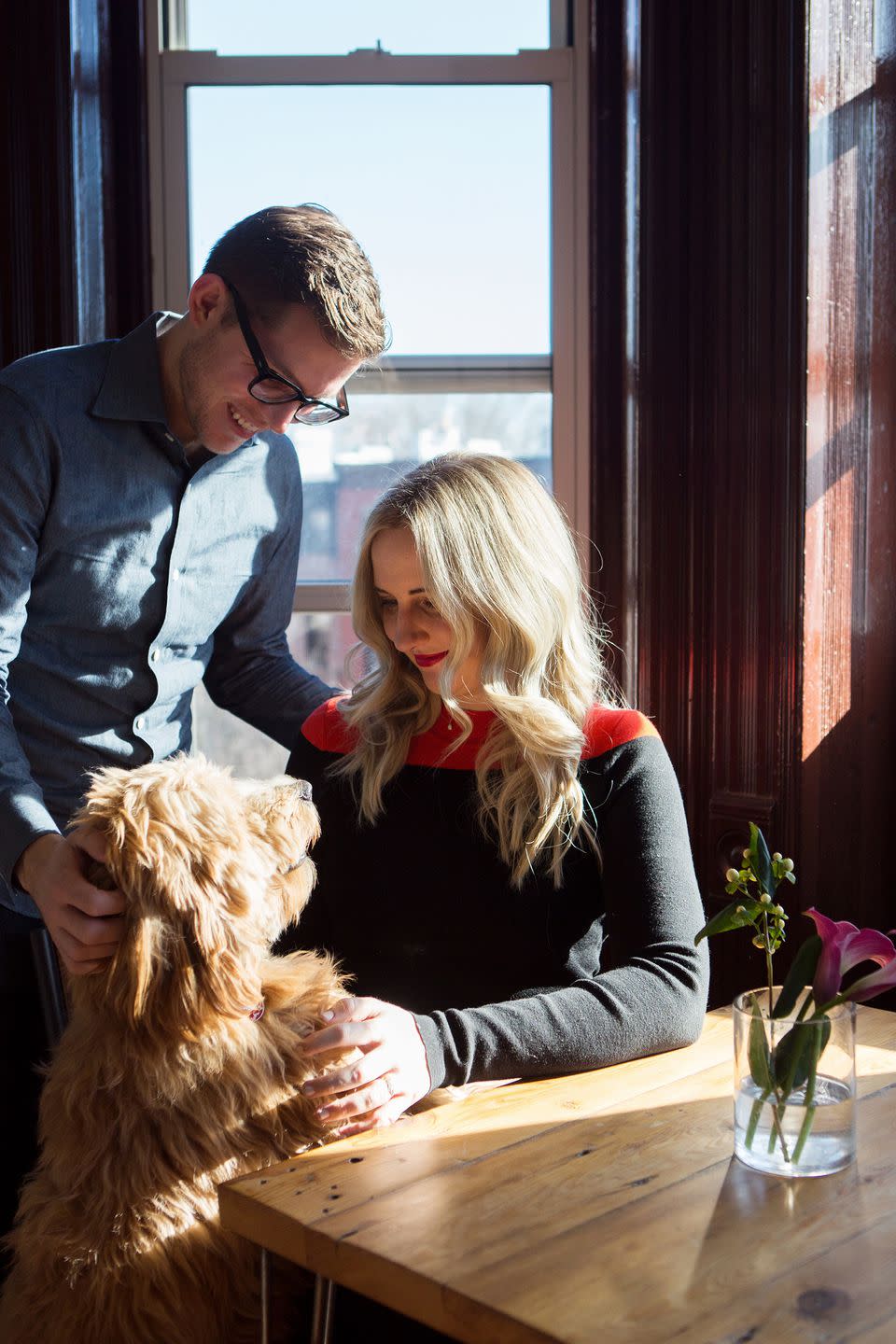
Although I wistfully recalled the days of obsessing over silly wedding stuff with my bridesmaids, refocusing my wedding planning wasn’t all negative. Engagement, after all, isn’t supposed to be all about calligraphy and silk, it’s supposed to be about planning a future with your partner. Mike and I were still very much on the fence about having kids, but now that he was about to marry a woman with only one working ovary, we were forced to talk more openly about our reproductive future. Should I take the risk of injecting myself with hormones that could trigger the cancer to come back in order to freeze my eggs or our embryos? Did we even care, if we might not want kids anyway? It was a lot to process - picture your life in 10 years, 15 years, and tell me with certainty what it will look like - especially given the precariousness of my own future. Stage 1C ovarian cancer patients have a 5-year survival rate of 85 percent, and there’s a 10 percent chance my cancer will come back at some point, according to the Ovarian Cancer Research Fund Alliance. Exhausted, we let the conversation go, and decided to pick it up after the wedding.
(In the midst of all that, my doctor pointed out a small moment of grace and irony: my birth control likely saved my life. I had a Mirena IUD, and the small doses of estrogen being secreted from the plastic implant likely stopped the GCT from spreading to my other organs, which can often be a death sentence. I felt a certain amount of fortitude that my choice to take control of my reproductive health five years ago had paid off in such an unexpected way.)
In October, with three weeks to go before the wedding, I had another follow-up with my oncologist-gynecologist. I laughed to myself at the dark irony of the waiting room: a bunch of strangers fighting for their lives, wondering if their cancer was back, while flipping through old issues of People to see who Taylor Swift is dating this month. It was a perfect depiction of my mental state: outside, I fussed about getting my gown alterations done on time like every other engaged thirtysomething; privately, I worried about the possibility of needing emergency surgery on my wedding day.
A nurse escorted me to a patient room with ice-blue walls, where I changed into a hospital gown and waited. The doctor came in a few minutes later. “How are you feeling?” she asked.
“Ok,” I told her, but the sound of the word coming out of my mouth made me realize what a bold-faced lie it was. Everything I had been holding in the past six months came out in ragged sobs - the fatigue and pain and fear. She gave me a few minutes to compose myself, then started her exam, solemnly, silently palpating my middle.
“You’re all clear,” she said with a smile. “I didn’t feel anything abnormal, but let’s get you a blood test and an ultrasound just to be sure.” It wasn’t remission, per se, but it was NED, short for No Evidence of Disease. Because my type of cancer is never really gone, that was the best I could ever hope for. And I’d happily take any acronym that meant we could get married next month without existential dread as my maid of honor.
As we counted down the days until our wedding, I let myself get genuinely excited about the details: picking out my rehearsal dinner outfit, sending our schedule to the photographer, harassing my extended family to RSVP. It felt so normal. Still, I couldn’t disperse a fog of depression around me. I felt an incredible sense of loss; sure, this body helped me survive cancer, but now it couldn’t be trusted - I could still relapse six months from now, or a year, or five. And there was some small, shallow part of me was still focused on the fact that I would always have wedding pictures that showed me far above what I considered my ideal weight.
I laid in bed the night before our wedding, shoving those insecurities to a dark corner of my mind. There was no point lamenting that I had to swap cotton linen for a poly blend or forgo a champagne toast because we were still paying down my surgery bill, or that I might need to skip some time on the dance floor so as to not wear myself out. I would still be the kind of glowing, glamorous bride I saw in my Pinterest feeds, I thought. Cancer had ruined a lot of things, but it wouldn’t ruin this.
Our wedding day was perfect - although not in a literal sense, of course. I ripped my Marchesa gown almost immediately after I put it on, the photographer didn’t have time for portraits, and there was a requisite drunk uncle or two. It was chaotic, a whirlwind of vows and dinner and dancing, but it was exactly what we had hoped it could be. By the end of the night, I was exhausted, but inexorably happy.
We’ve been married for a little over three months now, and I can officially report that life is quite good. Mike and I flew to the south of France the day after our wedding, where we ate a metric ton of cheese. We laughed too much, drank too much, and were as carefree as we’d been since that fateful day in May. I still have check-ins every three months with my oncological gynecologist, and am on high alert for the barely-there symptoms I missed the first time - mainly a feeling of fullness or bloating. I worry every time I pee, because maybe I’m going too much and that means the cancer’s back. But now that we’ve survived the initial shock of diagnosis, Mike and I are looking into freezing embryos. We've seen how much we need each other, and preserving our future for a family a little bit longer now feels very worth the risks.
It seems insane to plan a wedding through a cancer diagnosis, but all I can think now is that I’m so glad we didn’t wait. Life is messy and sometimes blindly cruel. But Mike and I made the best of it together, and came out better for it on the other side, which is honestly the best parallel to marriage I can think of. For us, it just meant putting the “in sickness and in health” part of our vows before the actual wedding.
Follow Beth on Twitter.
('You Might Also Like',)

